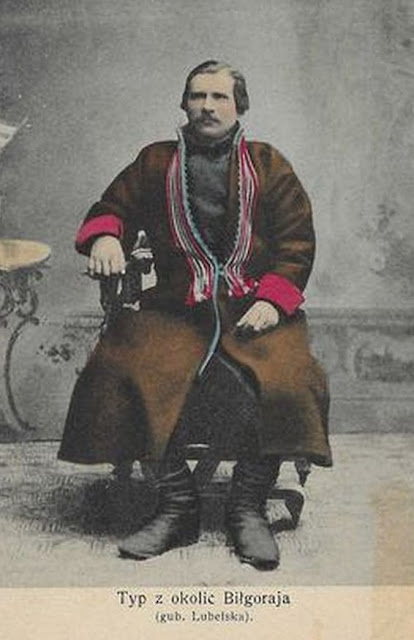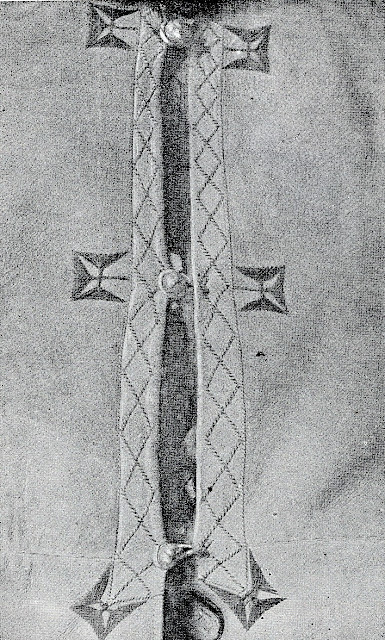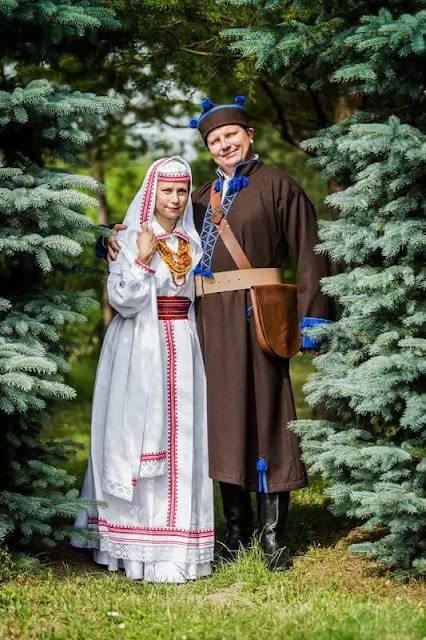Hello all,
Today I will continue my discussion of the Biłgoraj / Bilhoray costume. Today I will cover the men's costume and the outer garments. For more general information about this region, see my previous article.
MEN
Shirt.
The men's shirt, at least traditionally, was made with the same cut as the women's, only shorter.
Originally, the shirt was knee length, as was true for the wider region.
More recently, the shirt became shorter, to mid thigh,
And today, performing groups wear it barely hip length, as in the photo at the head of the article and here..
Shirts for everyday were of courser linen, without embroidery. Shirts for dress occasions often had embroidery on cuffs, collar, and sometimes the front placket.
Although examples of men's shirts embroidered in the local curvilinear embroidery are known, it seems that they more commonly were embroidered in simple cross stitch designs.
Plain linen pants were worn, either from flax or hemp. They were called portki. In winter, wool pants called kholoshnie were worn over them. In this image, the cut of the portki are shown in the top row, and that of the kholoshnie in the bottom.
The shirt was worn outside the pants, and a wide leather belt, pas, was worn over it. This could be very simple, but was often embellished with tooling, rivets, and up to 4 buckles. Obviously this depended on what a man could afford. A built in pocket was usual.
These belts were about 6 inches wide, and were similar to belts worn by men as far away as Austria and Romania.
Men and boys often went barefoot. In cold weather, they, like the women wore footcloths and moccasins called khodaky.
[It was often the case, and not only in this region, that people would walk barefoot and carry their boots, and put them on only when they got to church or whatever their destination was. This prevented the boots from getting worn out. Only those who were relatively well off would wear their boots walking the road.]
In the summer, straw hats were worn. Boys would braid green rye straw into bands, meters long, and then these strips would be sewn concentrically onto a form to make a hat. These kinds of hats kept the head cool and the neck shaded when working outside. In America, these have been replaced by feed caps that only have shade in the front for the eyes. Thus the back of the neck became regularly sunburned, which is the origin of the term 'redneck'.
In cooler weather, or dressier occasions, a wool hat was worn. This was called gamerka or hamerka. It was made of heavy home woven brown wool called sukno. Blue tassels or pompoms were attached to the four quarters and sometimes in the center as well.
Men wore shoulder bags were worn with this outfit. Typically they were made of leather and called kalita.
You will sometimes see a man wearing a bag woven of birchbark, which while not as durable, would certainly be cheaper.
OUTERWEAR
Summer outerwear for men was typically a long overcoat made of heavy linen or hemp. This was called polotnianka or parcianka. Often cloth intended for this garment was woven with a hempen warp and flaxen weft, in twill weave .This garment was popular in eastern Poland, western Ukraine, as and far north as Latvia.
This garment was usually completely unadorned, with only occasionally a small amount of cord or embroidery applied to the collar. It was fastened with hooks and eyes, one at the neck and 3 more spaced at about 12 cm intervals. It was not belted.
This man has an overcoat sewn with a different cut, providing much more fullness to the skirt of his garment.
On the little boy in this last image you can see a blue vest. If you look closely at the men above, you will see that many are wearing this vest under their linen overcoats, which seems to be the normal way of wearing it. This was also worn over a much wider area than just the Bilhoray / Bilgoraj region. Note that the vest is cut straight across on the bottom, with no points. Points on a vest are a strictly west European and American thing.
Both versions had a fold over cuff made of bought blue wool. Blue woolen cording was used to ornament the collar, cuffs, front closure, and hip seams of this garment. In the southeast part of this region, red cord was used instead. The ends of the cords were self fringed into tassels which also formed part of the ornament. Heavy hooks and eyes fastened the neck and front opening, with two more located at the waist. In the 20th cent. sukmanas began to be made with commercial wool cloth.
Note that the blue vest is visible under the sukmana in some of the above photos. Also, some newer photos show the sukmana worn with a belt or sash over it, this does not appear in any of the older photos.
Women also wore a version of the sukmana. It differed little from the men's garment and was also worn for important occasions. In the late 1800's, however, it was replaced by a different garment called zhupan.
The zhupan was ankle length and made from commercially produced wool in a bright blue color. The collar and turned back cuffs were appliqued in red wool. The seams and folds at the waist were ornamented with blue ribbon.
This garment was belted closed with a wide sash that wrapped 3 or 4 times around. It became an essential garment for brides, and was worn on all important occasions after marriage.
The last overgarment worn in this area was called kozhukh. This differed in being made from sheepskin. It was worn by both men and women. The cut was planned so that each piece could be cut from a single sheepskin. It typically takes 6 sheep to make one kozhukh.
The gores set into the sides were gathered into the waist and were ornamented with applique of very thin leather and embroidery. The front is closed by leather thongs made into loops on one side and knotted into buttons on the other.
There was actually one more garment worn, called shuba. This was an elaborate overcoat worn by women, made of sheepskin, with a second layer of bought wool cloth. Here is the layout of the garment. To the left is the front and rear of the finished garment. On the right above is the cut of the sheepskin, and on the right below the cut of the blue wool which covers it. I have found no images of this garment.
The woman on the right here has something wrapped around her neck like a wimple. This is NOT correct.
Thank you for reading, I hope that you have found this to be interesting and informative. This should help you to make your own outfits from this region.
Roman K
email: rkozakand@aol.com








.jpg)




.jpg)



































%20(3).jpg)





















.jpg)










.jpg)














.jpg)











































Thank you yet again for a wonderful journey - inspiring and interesting. Charlotte in California
ReplyDeleteI love reading your blog, Thank you so much.
ReplyDeleteThanks for sharing this valuable information. We will keep following you.
ReplyDeleteWomen Gothic clothing
This comment has been removed by a blog administrator.
ReplyDeleteThis is great information to have! Do you by chance know anything about traditional Luxembourgish clothings? Specifically women, I'm trying to sew my own dress as I'm getting more into the hobby! I was just wondering if you by chance knew about that topic and if not it's totally ok!
ReplyDeleteThanks for sharing such a informative post.
ReplyDeletemens american leather jacket
Do you have a website or portfolio where i can see your own self made clothing. I also make clothing my self and want to do a modeling show.
ReplyDelete